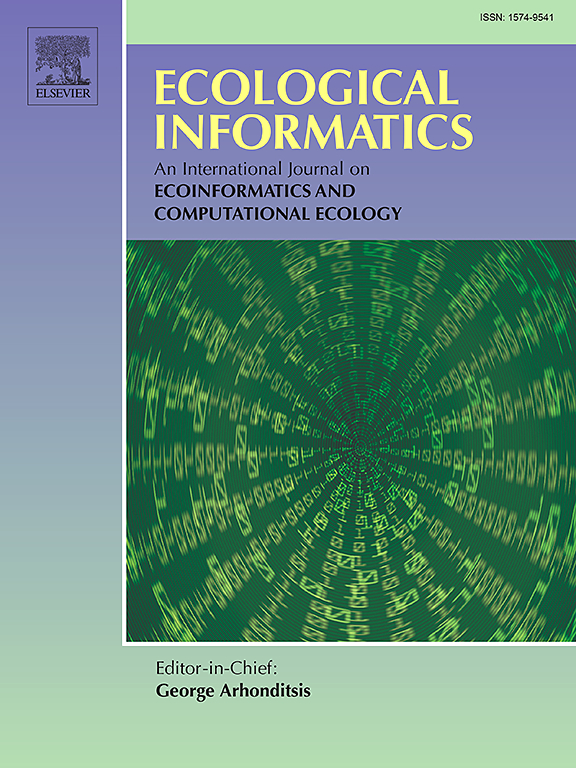底栖大型无脊椎动物功能多样性与河流生境质量:关键生物学性状分类
IF 7.3
2区 环境科学与生态学
Q1 ECOLOGY
引用次数: 0
摘要
利用底栖大型无脊椎动物计算功能多样性(FD)对淡水生态系统评价是有用的。然而,确定塑造社区的关键特征及其类别是至关重要的。本研究(i)研究了河流生境质量(以河流生境指数为特征)对大型功能无脊椎动物类别(FMaCs)和rRao FD指数趋势的影响;(ii)评估各FMaC提供的信息,以便沿FHI梯度计算rRao指数。大型无脊椎动物样本是在厄瓜多尔保罗河流域的12个地点收集的,历时6年。将大型无脊椎动物科划分为8个性状和42个fmac。k均值聚类分析根据其FHI值产生了三组采样点。对于每个FHI集群,计算每个FMaC在其相应性状中的百分比。计算FHI聚类值与先前获得的FMaC百分比之间的R2系数。对R2数据集进行第二次K-means聚类,得到三组与fmac直接相关的R2值。然后,我们评估了rRao指数对排除特定性状类别的敏感性,方法是按R2重要性的递减顺序依次去除fmac组。这使我们能够评估功能多样性估计的稳定性和鲁棒性,当信息较少的性状被删除。结果表明,某些fmac对rRao在生境质量集群中的变化有较大的影响,特别是与体型、运动和外骨骼硬度相关的fmac。在退化生境中,某些fmac对rRao变化贡献不大,表明在多性状功能空间内功能分化有限,可能降低这种条件下的监测价值。计算rRao指数最具信息量的特征是体型、柔韧性和运动性。这些发现有助于改进基于性状的大型无脊椎动物生态模型,并为河流管理者提供有关潜在生态水文压力源的见解。本文章由计算机程序翻译,如有差异,请以英文原文为准。
Functional diversity of benthic macroinvertebrates and fluvial habitat quality: Key biological trait categories
Functional diversity (FD) calculations using benthic macroinvertebrates are useful for freshwater ecosystem evaluation. However, it is critical to determine the key traits and their categories that shape a community. This study (i) investigated the effect of fluvial habitat quality (characterised by a fluvial habitat index – FHI) on the trends of individual functional macroinvertebrate categories (FMaCs) and the rRao FD index; and (ii) evaluated the information provided by each FMaC for rRao index calculation along the FHI gradient. Macroinvertebrate samples were collected at 12 locations in Ecuador's Paute River Basin over six years. Families of macroinvertebrates were classified into eight traits and 42 FMaCs. A K-means cluster analysis produced three groups of sampling points based on their FHI values. For each FHI cluster, the percentage of each FMaC within its corresponding trait was calculated. The R2 coefficient was computed between the FHI cluster values and the previously obtained FMaC percentages. A second K-means clustering was performed on the R2 dataset, resulting in three groups of R2 values directly associated with FMaCs. We then assessed the sensitivity of the rRao index to the exclusion of specific trait categories by sequentially removing groups of FMaCs, ordered by decreasing R2 importance. This allowed us to evaluate the stability and robustness of functional diversity estimates when less informative traits were removed. Results indicated that certain FMaCs had a greater influence on rRao variation across habitat quality clusters, particularly those related to body form, locomotion, and exoskeleton hardness. In degraded habitats, certain FMaCs contributed little to rRao variation, suggesting limited functional differentiation within the multi-trait functional space and potentially lower monitoring value under such conditions. The most informative traits for rRao index calculation were body form, flexibility, and locomotion. These findings contribute to improved trait-based ecological modelling of macroinvertebrates and offer insights for river managers regarding potential ecohydrological stressors.
求助全文
通过发布文献求助,成功后即可免费获取论文全文。
去求助
来源期刊

Ecological Informatics
环境科学-生态学
CiteScore
8.30
自引率
11.80%
发文量
346
审稿时长
46 days
期刊介绍:
The journal Ecological Informatics is devoted to the publication of high quality, peer-reviewed articles on all aspects of computational ecology, data science and biogeography. The scope of the journal takes into account the data-intensive nature of ecology, the growing capacity of information technology to access, harness and leverage complex data as well as the critical need for informing sustainable management in view of global environmental and climate change.
The nature of the journal is interdisciplinary at the crossover between ecology and informatics. It focuses on novel concepts and techniques for image- and genome-based monitoring and interpretation, sensor- and multimedia-based data acquisition, internet-based data archiving and sharing, data assimilation, modelling and prediction of ecological data.
 求助内容:
求助内容: 应助结果提醒方式:
应助结果提醒方式:


